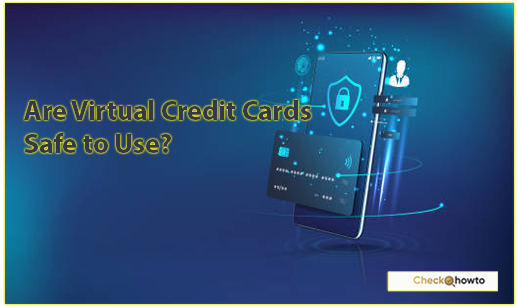As someone who shops online frequently, I’ve often wondered about the safety of my financial information. With cyber threats on the rise, protecting your personal data is more critical than ever. You may have heard about virtual credit cards and wondered, “Are they safe to use?”

In this article, I’ll explore what virtual credit cards are, how they work, their safety features, and whether they’re a good fit for you. I’ll also address their benefits, limitations, and practical tips to ensure you can shop online with confidence.
What Is a Virtual Credit Card?
A virtual credit card is a digital version of your physical credit card, designed specifically for online or in-app purchases. Unlike a traditional card, it exists only in digital form and comes with a unique 16-digit card number, expiration date, and security code that differ from your actual credit card. As explained by WalletHub, “Using a virtual credit card is like paying for every online transaction with a new credit card each time, protecting your actual credit card from fraud.”
When I first learned about virtual credit cards, I was intrigued by how they add an extra layer of security. For example, if you’re shopping on a new website and you’re unsure about its legitimacy, a virtual card ensures your real card details remain hidden. He or she can generate a virtual card through their bank or a payment service like Google Pay, PayPal, or Capital One, which supports this feature.
How Do Virtual Credit Cards Work?
To understand why virtual credit cards are considered safe, you need to know how they function. When you request a virtual card, your bank or payment provider generates a temporary card number linked to your actual credit card account. This number can be used for a single transaction, a specific merchant, or a set period, depending on the provider’s settings.
For instance, I recently used a virtual card through Google Pay for an online purchase. The process was seamless: I saved my credit card to my Google Account, enabled the virtual card option, and received a unique number to use at checkout. The merchant never saw my real card details, which gave me peace of mind. According to Google Pay’s support page, “Virtual card numbers can be shared with merchants for online or in-app transactions to keep your payment information secure.”
Virtual cards often come with customizable limits. You can set a spending cap or restrict the card to a single use, reducing the risk of unauthorized charges. If a hacker intercepts the virtual card number, it’s useless for future transactions, as it’s either expired or tied to a specific merchant.
Are Virtual Credit Cards Safe to Use?
The short answer is yes, virtual credit cards are generally safe to use, and they offer significant advantages over traditional credit cards for online shopping. Here’s why I believe they’re a secure option, along with insights from industry experts.
Enhanced Security Features
Virtual credit cards are designed to minimize the risk of data theft. By masking your real card details, they make it harder for cybercriminals to access your financial information. Experian notes, “These digital credit card numbers provide an extra layer of security—making it harder for cyber attackers to gain access to your personal information.”
For example, if you use a virtual card on a website that suffers a data breach, the compromised virtual number is typically useless to hackers. It’s either a one-time-use number or restricted to that merchant, unlike a physical card number that could be used elsewhere.
Fraud Protection
I’ve always been cautious about online fraud, and virtual cards address this concern effectively. Privacy.com emphasizes that virtual cards “shield your financial information and protect against credit and debit card fraud with secure, randomly-generated virtual card numbers.” If fraudulent charges do occur, they’re limited to the virtual card’s settings, and your main account remains untouched.
Control and Flexibility
One feature I love about virtual cards is the control they offer. You can set spending limits, expiration dates, or merchant-specific restrictions. For instance, Forbes Advisor highlights that virtual cards “provide some peace of mind without complicating the payment process.” This flexibility ensures that even if a virtual card is compromised, the damage is minimal.
Real-World Example
Last month, I used a virtual card to subscribe to a streaming service. I set a spending limit equal to the monthly fee and restricted the card to that merchant. Even if the service’s database were hacked, the virtual card couldn’t be used elsewhere, and my actual credit card remained secure. This experience convinced me of their practicality.
Limitations of Virtual Credit Cards
While virtual credit cards are safe and convenient, they’re not perfect. You should be aware of their limitations to decide if they’re right for you. Experian points out that “virtual credit cards can be a convenient option, but you may not be able to use them for in-store purchases and other traditional transactions.”
Not Suitable for In-Person Purchases
Virtual cards are digital-only, so you can’t use them at physical stores or ATMs. If he or she relies on a single credit card for both online and offline purchases, this could be inconvenient.
Limited Availability
Not all banks or credit card issuers offer virtual cards. I was disappointed to find that one of my cards didn’t support this feature, forcing me to use a payment service like PayPal instead. You’ll need to check with your provider to see if virtual cards are available.
Potential for Confusion
Managing multiple virtual cards can be overwhelming, especially if you generate new numbers for every transaction. Keeping track of which card is linked to which merchant requires organization, something I’ve had to learn the hard way.
Tips for Using Virtual Credit Cards Safely
To maximize the safety of virtual credit cards, follow these practical tips based on my experience and industry best practices:
- Choose Reputable Providers: Use virtual cards from trusted providers like Google Pay, PayPal, or major banks like Capital One. These companies invest heavily in security measures like encryption and tokenization.
- Set Spending Limits: Always set a spending cap or single-use restriction to minimize potential losses.
- Monitor Transactions: Regularly check your account for unauthorized charges, even with virtual cards.
- Use Secure Websites: Ensure the website you’re shopping on uses HTTPS and has a legitimate reputation. Virtual cards can’t protect you from phishing scams.
- Update Your Software: Keep your devices and apps updated to prevent vulnerabilities that could expose your virtual card details.
Should You Use a Virtual Credit Card?
After exploring the ins and outs of virtual credit cards, I’m convinced they’re a valuable tool for anyone who shops online. They offer robust security features, protect against fraud, and give you control over your transactions. However, they’re not a one-size-fits-all solution. If you primarily shop in-store or prefer simplicity, a traditional credit card might suffice.
CNET sums it up well: “Add another layer of defense against hackers the next time you check out.” Whether you’re a frequent online shopper or just want extra peace of mind, virtual credit cards are worth considering.
For me, the decision to use virtual cards came down to prioritizing security without sacrificing convenience. I encourage you to check with your bank or payment provider to see if virtual cards are available and experiment with them for your next online purchase. He or she might find, as I did, that they’re a game-changer for safe and stress-free shopping.
Conclusion
Virtual credit cards are a safe and effective way to protect your financial information online. By masking your real card details, offering fraud protection, and providing customizable controls, they address many of the risks associated with online shopping. While they have limitations, such as being unsuitable for in-store purchases, their benefits far outweigh the drawbacks for digital transactions.
I hope this article has answered your question, “Are virtual credit cards safe to use?” and provided you with the insights you need to make informed decisions. If you’re ready to enhance your online payment security, give virtual cards a try—you won’t regret it!



